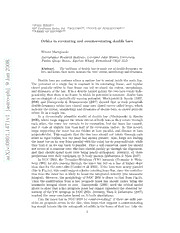Table Of Content**FULL TITLE**
ASP Conference Series, Vol. **VOLUME**, **YEAR OF PUBLICATION**
**NAMES OF EDITORS**
Orbits in corotating and counterrotating double bars
Witold Maciejewski
Astrophysics Research Institute, Liverpool John Moores University,
8 Twelve Quays House, Egerton Wharf, Birkenhead CH42 1LD
0
0
Abstract. The backbone of double bars is made out of double-frequency or-
2
bits,andloops,theirmaps,indicatethebars’extent,morphologyanddynamics.
n
a
J Double bars are systems where a nuclear bar is nested inside the main bar.
9 The potential of a single bar is constant in its corotating frame, and regular
closed periodic orbits in that frame can tell us about the extent, morphology,
]
h and dynamics of the bar. If in a doubly barred galaxy the two bars rotate inde-
p pendently, then there is no frame, in which its potential is constant: double bars
-
are an example of a periodically varying potential. Maciejewski & Sparke (1997,
o
r 2000) and Maciejewski & Athanassoula (2007) showed that in such potentials
t
s double-frequency orbits (not closed) map onto closed curves called loops, which
a
indicate the extent, morphology and dynamics of doublebars, as closed periodic
[
orbits do in a single bar.
1 In a dynamically plausible model of double bar (Maciejewski & Sparke
v
2000), whereloops supportthe wholeextent of bothbars as they rotate through
1
each other, the outer bar extends to its corotation, but the inner bar cannot,
7
4 and it ends at slightly less than half of its corotation radius. In this model,
1 loops supporting the inner bar are thicker at bars parallel, and thinner at bars
.
1 perpendicular. This suggests that the two bars should not rotate through each
0 other as rigid bodies, but the inner bar should pulsate. Also, loops are leading
8 the inner bar on its way from parallel with the outer bar to perpendicular,while
0
they trail it on its way back to parallel. Thus a self-consistent inner bar should
:
v not rotate at a constant rate: the bars should quickly go through the alignment,
i
X and they should spend more time being nearly-orthogonal. Recently, all these
predictions were fully confirmed by N-body models (Debattista & Shen 2007).
r
a In NGC 2950, the Tremaine-Weinberg (TW) integrals (Tremaine & Wein-
berg 1984) for slits passing through the inner bar fall on a line of higher slope
than that for the outer slits (Corsiniet al. 2003). If the bars were nearly parallel
(like in Fig.1a), thiscould suggest afaster rotating innerbar,since thecontribu-
tion from the inner bar is likely to boost the integrated velocity (the kinematic
integral). However, the morphology of NGC 2950 is closer to that from Fig.1b.
Then the contribution from a fast prograde inner bar should rather bring the
kinematic integral closer to zero. Maciejewski (2006) used the orbital model
above to show that a fast prograde inner bar cannot reproduce the observed be-
haviour of the TW integrals in NGC 2950. Recently, Shen & Debattista (2007)
reached the same conclusion based on N-body simulations.
Can the inner bar in NGC 2950 be counterrotating? If there are only par-
ticles on prograde orbits in the disc, then loops that support a counterrotating
barshouldbehaveliketheretrogradex4orbitsintheframeof thatbar. Likethe
1
2 Maciejewski
Figure 1. a, b: Two relative positions of the bars (ellipses), with rotation
indicated by arrows. Double line marks the slit. c: Retrograde loops in two
prograde bars. d: Retrograde loops in outer prograde and inner retrograde
bar. Major axes of the bars are drawn, the outer bar is always horizontal.
x4 orbits, retrograde loops in prograde double bars are almost circular (Fig.1c),
hence they cannot support the formation of a retrograde bar in a fully pro-
grade disc. However, if there is a retrograde population in the disc, then the
retrograde inner bar can be built out of it. In that case, the prograde orbits
in the outer bar correspond to the retrograde ones in the inner bar and vice
versa. Retrograde loops in double bars, where the outer bar is prograde and the
inner bar retrograde, support the shape of the inner bar throughout its extent,
and they rotate with that bar, showing no signs of pulsation or acceleration
(Fig.1d). Thus counterrotating double bars should rotate fairly rigidly through
each other, keeping the linear relations between the TW integrals, observed in
NGC 2950, which otherwise may be erased by the pulsation of corotating bars
(Shen & Debattista 2007). Since the TW integrals utilize the integrated signal,
it may be easier to detect counterrotation from them than directly in velocity
maps. This work was supported by the Polish KBN grant 1 P03D 007 26.
References
Corsini, E. M., Debattista, V. P., & Aguerri, J. A. L. 2003, ApJ, 599, L29
Debattista, V. P., & Shen, J. 2007, ApJ, 654, L127
Maciejewski, W. 2006, MNRAS, 371, 451
Maciejewski, W., & Athanassoula, E. 2007,MNRAS, 380, 999
Maciejewski, W., & Sparke, L. S. 1997, ApJ, L117
Maciejewski, W., & Sparke, L. S. 2000, MNRAS, 313, 745
Shen, J., & Debattista, V. P. 2007, ApJ, submitted (arXiv:0711.0966v1)
Tremaine, S., & Weinberg, M. D. 1984, ApJ, 282, L5

